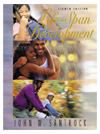 |  Life-Span Development, 8/e John W. Santrock,
University of Texas - Dallas
Middle and Late Childhood Socioemotional Development in Middle and Late Childhood
Chapter ObjectivesI.Understand the shift in development of self-understanding during middle and late childhood. |
 |  |  | II.Define self-esteem and self-concept, and discuss ways to increase children's self-esteem. |
 |  |  | III.Explain Erik Erikson's fourth stage of psychosocial development. |
 |  |  | IV.Examine the changes in emotional development that take place in this period and discuss emotional intelligence. |
 |  |  | V.Describe Kohlberg's theory of moral development, as well as criticisms of it. |
 |  |  | VI.Discuss Carol Gilligan's alternate theory of moral development. |
 |  |  | VII.Define prosocial behavior and altruism, and understand ways to increase altruism in children. |
 |  |  | VIII.Examine gender stereotypes and gender similarities and differences. |
 |  |  | IX.Discuss gender-role classification, including androgyny and gender-role transcendence, and the importance of considering gender in context. |
 |  |  | X.Explain how parent-child interactions in the family change during middle and late childhood. |
 |  |  | XI.Describe both the short-term and long-term effects of living in stepfamilies. |
 |  |  | XII.Define the term latchkey children and elaborate on ways to reduce the risk to these children. |
 |  |  | XIII.Expound on the four peer statuses. |
 |  |  | XIV.Identify the parent-child relationships that characterize bullies and victims, as well as the effects of bullying and strategies to reduce bullying. |
 |  |  | XV.Explain what social cognition is and why it is important. |
 |  |  | XVI.Examine the importance of children's friendships. |
 |  |  | XVII.Discuss the transition to elementary schools, how socioeconomic status and ethnicity impact education, and ways to improve relations among ethnically diverse groups. |
 |  |  | XVIII.Examine the cross-cultural differences in levels of achievement. |
|



 2002 McGraw-Hill Higher Education
2002 McGraw-Hill Higher Education